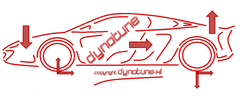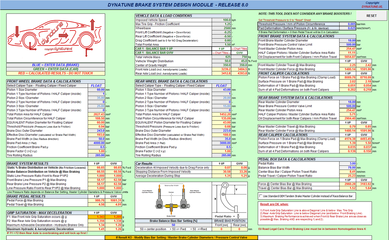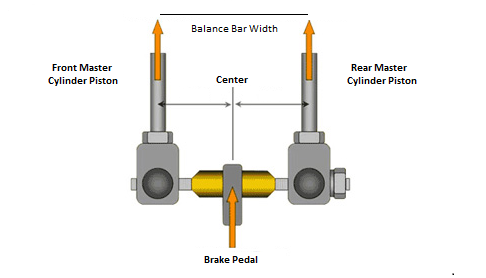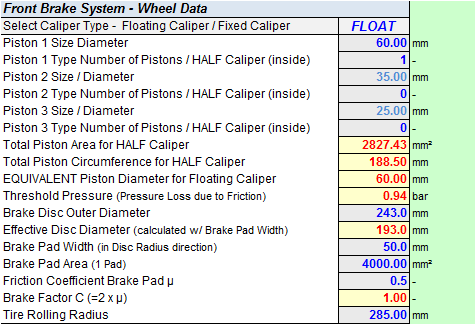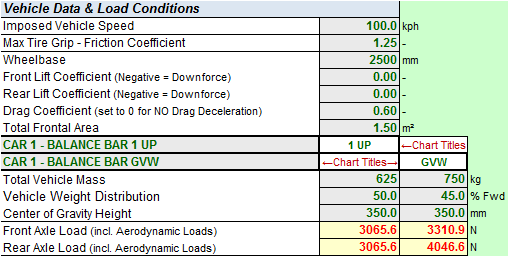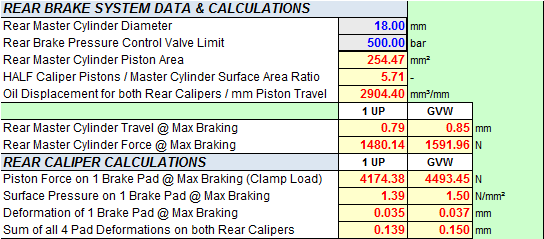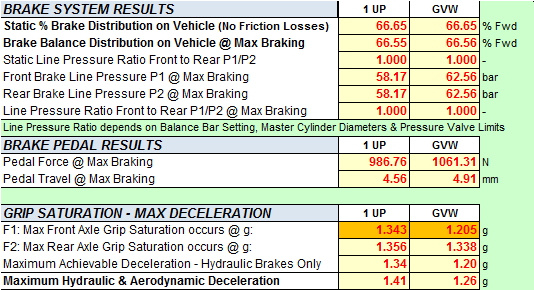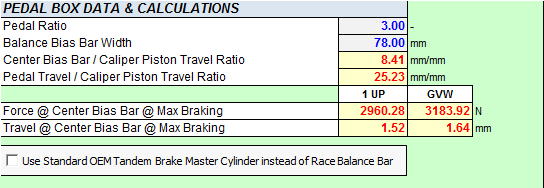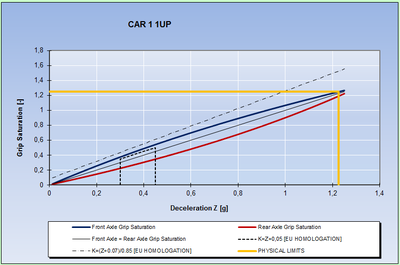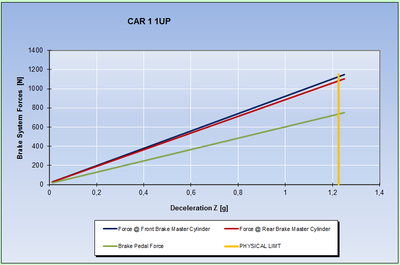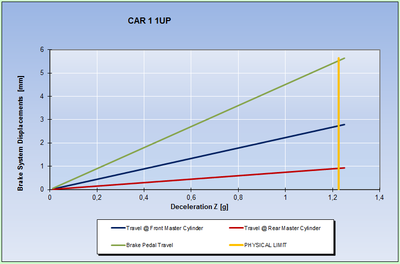DYNATUNE-XL BRAKE-SYSTEM DESIGN MODULE (BDM)
|
The DYNATUNE-XL BRAKE-SYSTEM DESIGN MODULE has been specifically developed focusing on optimizing the interactions between the hardware components and the reuslting performance of hydraulic braking systems. DYNATUNE-XL BDM allows to investigate two vehicles each in two different load conditions and compare their key hydraulic operating points and braking performance characteristics.
DYNATUNE-XL BDM has been designed for Caliper/Disc Systems, does NOT consider any Brake Boost Devices and can either be governed by a Brake Balance Bias Bar - which defines directly the Brake Distribution between the Front and Rear Axle - or a Tandem Brake Master Cylinder with corresponding Brake Pressure Relief Valves in the system. |
BRAKE-SYSTEM input data
|
As expected, the primary Brake System Data required includes details of the Brake Calipers and Discs. The Calculation Algorithm operates on the basis of a 1 Piston Floating Caliper, with the piston located on the inside of the disc. All data from Fixed (multi-piston) Calipers is internally converted to adhere to this principle. The tool accommodates up to 3 different sizes of pistons, providing maximum flexibility in geometric design. If an even more (8 - 10) piston caliper design is being analised one can simply revert to matching the total "lumped" piston area for correct representation of such components.
In addition to the data for Front and Rear Wheel Brakes, dimensions of the Master Cylinders must be supplied along with basic geometry data of the Brake Balance Bias Bar and Brake Pedal Dimensions. |
And some Specific Data to consider the effects of Piston Friction and Brake Pad Deformation.
|
From RELEASE 8.0 onward, Users have the option to choose between a Standard OEM Tandem Brake Master Cylinder or the previously available Brake Balance Bias Bar commonly used in Racing Applications. All internal calculations will be executed based on the user's selection. This added feature now makes DYNATUNE-XL BDM fully applicable to a wide range of OEM Vehicle Hydraulic Brake System Layouts.
VEHICLE Data
|
The crucial vehicle data required includes Vehicle Mass, Weight Distribution, Center of Gravity Height, and Wheelbase, as these parameters define longitudinal load transfer and wheel loads during braking. The tool can also consider two load conditions of the vehicle.
Axle loads are generated for the imposed vehicle speed. It's noteworthy that from RELEASE 8.0 onward, DYNATUNE-XL BDM is fully capable of simulating high downforce vehicles and particularly takes into account the impact of high drag coefficients on overall braking performance. |
RESULTS
|
NUMERICAL RESULTS provide all info on the Braking System for two load conditions. Key brake operating characteristics include Brake Line Pressure (and the Front-to-Rear Ratio) and Brake Pedal Force % Travel. Based on the provided vehicle and tire data, the tool automatically calculates Grip Saturation at each axle for the given brake balance distribution.From RELEASE 8.0 onward, both Hydraulic and Aerodynamic Braking Performance are presented in the Results Table.
Furthermore, all insightful details of the Braking System are accessible as intermediate results. A Brake Pressure Control Valve can limit the maximum Brake Line Pressure if needed. |
And also all important details of the Brake Pedal for the Selected Master Cylinder Configuration.
|
And the final Vehicle Result: Stopping Distance
The GRAPHICAL RESULTS comprise three graphs, with the classical Axle Grip Saturation vs. Vehicle Deceleration Graph being the most crucial. The other graphs display Brake System Actuation Forces and Displacements. All graphs include an indication of the Physical Limit of the Vehicle. Additionally, the first graph considers some of the EU-Homologation requirements as a reference guide for street-legal vehicles.
This workbook also includes a COMPARISON Sheet where all key parameters and graphs for two vehicles (and their two load conditions) are listed, enabling an effortless side-by-side comparison of variants. Refer to the BDM PDF file for more details.
